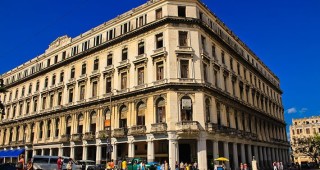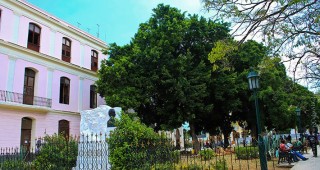The building of the railway station, expression of the Spanish plateresque style, was built in 1912 on the site of the former Armory. It has four floors with 77 windows and the main entrance is rounded off by two slender towers, whose terracotta and tile ornamentation includes the coats of arms of both the city and the nation. It used red Spanish slates for the roofs and a huge clock was featured in the center of the façade. The ground floor, which was used as waiting room, exhibits columns faced with marble. The trains entered the terminal by way of a viaduct of over one kilometer long, which has been known since as “Los Elevados” [The Elevated].

Manzana de Gómez LH  4
4
Owned by Julián de Zulueta, construction work began in 1890 according to the project designed by architect Pedro Tomé Veracruisse; however, still unfinished, it was sold to Andrés Gómez Mena, who comp …
 EclecticAdmission: n-aLimited by Neptuno, Monserrate, Obispo and Zulueta Streets, Habana Vieja
EclecticAdmission: n-aLimited by Neptuno, Monserrate, Obispo and Zulueta Streets, Habana Vieja 
Teatro Nacional de Cuba LH  4
4
Opened in 1960, and reopened in 1979 after being fully restored, this is one of Havana’s most important cultural venues. It promotes dance, drama, theater for both adults and children, music and visua …

La Terraza de Cojimar LH  4
4
Ernest Hemingway lived in Cojimar for some years and this was his favorite restaurant there, as evidenced by the many pictures of the American author here, including one with Fidel Castro. In one of t …

Edificio FOCSA LH  4
4
Considered one of the seven wonders of Cuban civil engineering, when built, the Focsa building was among the largest reinforced concrete structures in the world. Construction works took 28 months, and …
 Modern17 entre M and N
Modern17 entre M and N 
Teatro Martí LH  4
4
Elegant and simple, this Romanesque-style theater opened in 1884 as Teatro Irijoa and changed its name to Teatro Martí in 1900. Because of its location in Habana Vieja and its great acoustics, it achi …

Sloppy Joe’s Bar LH  5-
5-
6pm is Sloppy Joe cocktail hour again at the original Sloppy Joe’s saloon, an iconic Cuban bar that reopened Friday April 12, 2013 after a nearly 50-year break in its original location. The restoratio …
 Traditional BarÁnimas, esq. Zulueta La Habana Vieja
Traditional BarÁnimas, esq. Zulueta La Habana Vieja 
Fototeca de Cuba LH  4
4
Inaugurated in 1986 to preserve, study and promote Cuba’s photographic heritage, Fototeca de Cuba, mid-way along the east side of the plaza, boasts the nation’s largest, most valuable collectio …

Plaza del Cristo LH  4
4
The mid-17-century plaza takes its name from the Iglesia del Santo Cristo del Buen Viaje. It was first known as Plaza Nueva taking the name of what is now known as Plaza Vieja. For a while it was know …

Parque John Lennon LH  4
4
Occupying a whole block, the park delimited by 17, 15, 6 and 8 Streets had been unofficially known as John Lennon for years and had been a popular meeting place for young people and sometimes imprompt …

La Bodeguita del Medio LH  4
4
Back 1942, this well-known restaurant was a small grocery store. Its owner, Ángel Martínez, began to sell food as the number of customers increased. One day, journalist Leandro Garcia, a regular costu …



